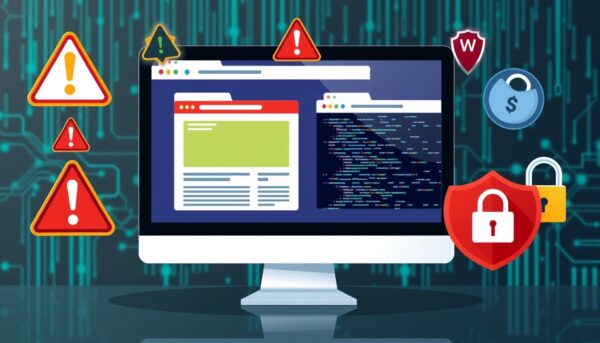✅ Last checked on
Could your favorite online marketplaces or banking sites be silently targeting you with malicious attacks?
In our digital world, keeping your online safety top of mind is crucial. Malicious websites, disguised as trusted sites, pose a threat to your personal info and security. These sites, designed for cybercrime, are a hidden danger many users face every day.
They can steal your sensitive data or install harmful software. The threats are real and widespread.
Recent stats show malicious websites cause over 90% of cyberattacks worldwide. Phishing attacks have doubled in two years, with 4.3 billion emails sent daily. Sadly, over 60% of users don’t check URLs before sharing personal info, making them easy targets.
This section highlights the dangers of malicious websites and the need for strong protection. Learn how to protect yourself with effective malware protection and website security strategies. Stay safe in the digital world.
Key Takeaways
- Malicious websites disguise themselves as legitimate platforms to steal sensitive data.
- Phishing attacks and malware distribution are common threats linked to harmful sites.
- Over 90% of cyberattacks globally originate from malicious websites.
- Safe Browsing has evolved since 2005 to protect against various cyber threats.
- Regularly updating your browser and software is critical for malware protection.
- Aggressive pop-ups and redirects often indicate the presence of harmful sites.
Understanding Malicious Websites and Their Threats
In today’s digital world, malicious websites pose a big threat to online users. They use different tactics to steal personal info and harm system security. It’s key to know these threats to protect against Malware Protection. A report by the AV-TEST Institute shows over 450,000 new malicious programs are found every day. This shows how big the problem is.
Phishing Attacks
Phishing Attacks have jumped nearly 60% worldwide, making 2023 the worst year, says the Anti-Phishing Working Group. These scams look like real sites to get users to share sensitive info like login details and personal data.

Malware Distribution
Malicious sites often spread malware. Users might download harmful software without knowing, causing big problems. Drive-by downloads are a big worry where malware installs itself just by visiting a bad site or opening an email.
Cryptojacking
Cryptojacking scripts secretly use visitors’ resources to mine cryptocurrency. This makes devices run slower and raises electricity bills. Stopping cryptojacking needs strong Malware Protection solutions.
Scareware
Scareware tricks users into downloading fake security software by showing fake threats. This scam is very good at getting users to install unwanted programs that can harm their security.
How to Identify Malicious Websites
Spotting malicious websites is crucial for staying safe online. Being alert helps you avoid threats and keep your browsing safe. Knowing the signs can stop phishing attacks and other cyber dangers.
Unusual URLs and Misspellings
Watch out for URLs that look off or have typos. Legit sites like Google or Salesforce might have fake versions to trick you. In 2023, over 1000 companies faced brandjacking, with 51.7% being big names. Checking the URL carefully can protect you.
Lack of HTTPS
Always look for HTTPS in a website’s URL. Sites with HTTPS keep your data safe. Without HTTPS, your info might be at risk. This simple check is key to safe browsing.
Aggressive Pop-ups
Be wary of pop-ups that push you to act fast. They might ask for downloads or personal info. Too many pop-ups often mean a site is bad, leading to big losses and damage.
Mismatched Branding
Also, watch for sites with wrong branding. Look for odd logos or colors compared to real companies. This is a sign of a fake site. Staying alert and using safe browsing habits can keep you safe.

| Indicator | Description | Examples |
|---|---|---|
| Unusual URLs and Misspellings | Look for URLs with slight spelling errors or irregular formats. | Go0gle.com, Sale5force.com |
| Lack of HTTPS | Check for HTTPS in the URL to ensure data encryption. | http://example.com (insecure) |
| Aggressive Pop-ups | Beware of numerous pop-ups requesting immediate action. | Fake security alerts |
| Mismatched Branding | Inspect for inconsistent logos and design elements. | Incorrect company logo |
By spotting these signs, you can better protect yourself online. This makes your digital world safer.
Tools and Techniques to Block Malicious Websites
In today’s digital world, Web Filtering, DNS Rules, and SSL/TLS Inspection are key to protecting your browser. With the internet growing by 1,355 percent since 2020, it’s crucial to use strong Internet Security Solutions. This helps keep your online activities safe.
Web Filtering Solutions
Web Filtering solutions block harmful sites by using big databases of bad URLs. They can cut malware risk by up to 50% in companies that use them well. You can block certain sites or use keywords to keep out bad content.
Market trends show the content filtering market will grow by 8.9% each year. It’s expected to hit $3.8 billion by 2026. Adding AI to these solutions makes them better by automatically sorting content.
Using DNS Rules for Domain Reputation
DNS Rules help check if a domain is safe and block bad sites. Services like Umbrella keep a big list of threats. They protect all devices on your network, including phones and tablets.
By stopping devices from talking to bad domains, you can fight threats well. For more on DNS, see this detailed DNS explanation.
SSL/TLS Inspection Tools
Now, 85% of malware spreads through web browsing. SSL/TLS Inspection tools are key for finding threats in encrypted traffic. They help keep your browsing safe by spotting risks.
Having SSL/TLS Inspection in your security plan means you won’t miss any threats, even in secure channels.
| Tool/Technique | Function | Benefits |
|---|---|---|
| Web Filtering | Blocks harmful sites | Reduces malware risk by up to 50% |
| DNS Rules | Assesses domain reputation | Prevents communication with compromised domains |
| SSL/TLS Inspection | Decrypts and inspects encrypted traffic | Unveils hidden threats |
Using Web Filtering, DNS Rules, and SSL/TLS Inspection can greatly improve your defense against web threats. These Internet Security Solutions make browsing safer for all devices on your network.
Employing Safe Browsing Practices
In today’s world, cybercrime is on the rise. It’s crucial to keep your personal info safe online. By using updated software, strong passwords, and regular security checks, you can stay ahead of threats.
Regular Browser and Software Updates
Keeping your browser and software up to date is key. Browser flaws are behind over 50% of cyber attacks. Updates bring vital security fixes to keep you safe from new threats.
Use of Secure Passwords
Strong, unique passwords are essential for online safety. About 50% of workers reuse passwords, which is risky. Using strong passwords and 2FA can boost your security. Remember, human mistakes cause 90% of data breaches, making good passwords critical.
Regular Security Audits
Regular security checks can spot and fix vulnerabilities before hackers do. Hackers often use stolen accounts to get into systems. This makes regular audits crucial for online safety. Cybersecurity training can cut data breach risks by up to 70%, showing the need for constant vigilance.
By following these safe browsing tips, you protect your online world. Regular updates, strong passwords, and security audits help fight cyber threats. This way, you ensure a safer online experience for everyone.
| Practice | Impact on Security |
|---|---|
| Regular Updates | Mitigates 50% of cyber attacks |
| Secure Passwords | Reduces data breaches by 90% |
| Security Audits | Decreases breach risk by 70% |
Protecting Your Devices with Sophos Home
Sophos Home offers a wide range of features to keep your devices safe. It uses advanced AI and behavioral analysis to protect millions of users. It guards against harmful websites and ransomware attacks.
Parental Controls
Sophos Home’s Parental Controls are a key feature. They help parents manage their kids’ online activities. You can block bad content and set limits on how much time they spend online.
AI Threat Detection
The AI Threat Detection in Sophos Home is top-notch. It finds and blocks harmful websites and threats right away. This system watches for suspicious actions, lowering the chance of malware and hacking.
Ransomware Security
Sophos Home also focuses on ransomware security. It watches for signs of unauthorized encryption and stops it fast. This keeps your data safe from ransomware, a big cyber threat today.
| Feature | Description | Impact |
|---|---|---|
| Parental Controls | Manage and monitor children’s online activities | Ensures safe browsing for kids |
| AI Threat Detection | Real-time protection using behavioral analysis | Blocks malicious websites and threats |
| Ransomware Security | Monitors for unauthorized encryption activities | Prevents data loss from ransomware |
| Updated Threat Intelligence | Real-time updates from SophosLabs | Keeps protection measures current |
Google’s Enhanced Safe Browsing Features
Google’s Enhanced Safe Browsing is a strong defense against cyber threats. It uses real-time checks and custom defenses to keep your online experience safe.
Real-time Checks Against Phishing and Malware
Enhanced Safe Browsing scans for phishing and malware non-stop. It checks over 10 billion URLs and files every day. This keeps your devices safe from new threats.
It warns you about dangerous sites, downloads, and extensions. Google Safe Browsing spots these risks.
Tailored Protections Based on Risk Level
Google’s Enhanced Safe Browsing tailors security to your risk level. Enhanced protection mode uses AI to block attacks. This boosts phishing detection by 25% compared to basic protection.
This feature also protects Google services if you’re signed in. It helps keep your Gmail safe after threats.
Additional Protections in Gmail and Google Products
Enhanced Safe Browsing also guards Gmail and other Google products. It does real-time phishing checks and deep scans. This gives you full protection against online threats.
You can turn this feature on or off in your Google Account settings. This way, you get defenses that fit your needs and better Gmail security.
Google Safe Browsing protects over 5 billion devices worldwide. Chrome users get warnings for compromised passwords. Enhanced protection doesn’t slow down your browser, but it does boost your digital safety.
| Features | Standard Protection | Enhanced Protection |
|---|---|---|
| Updates Frequency | Every 30 to 60 minutes | Real-time |
| Data Utilization | Limited known threats | AI and cloud database integration |
| Phishing Detection | Basic protection | Up to 25% more effective |
| Cross-Service Protection | Only on Chrome | Extended to Gmail and other services |
Your digital safety is very important. With Google’s updates, you’re ready to face new cyber threats.
Conclusion
In the world of cybersecurity, it’s key to protect against harmful websites. With 90% of phishing attacks starting with malicious sites or links, the danger is real. It’s vital to know, spot, and block these threats to keep our digital worlds safe.
Experts say keeping browsers and software updated, using strong passwords, and doing security checks often is crucial. Tools like DNS filtering and endpoint protection are key to fighting malware. Solutions like Sophos Home and Google’s Safe Browsing also play a big role in keeping us safe.
Studies show that 85% of security problems come from malware downloaded online. This makes being careful online even more important. Browser protection and VPNs can greatly reduce risks. Also, teaching your team about cybersecurity is a must.
Staying alert and using new security tools is essential as threats grow. By being proactive and using tools from Control D, we can make our networks safer. Keeping antivirus software current, scanning often, and using multifactor authentication can block many attacks.